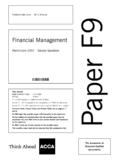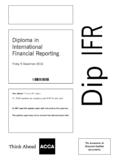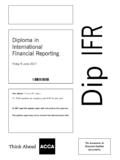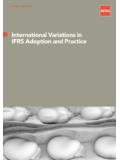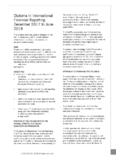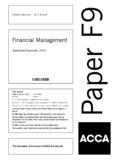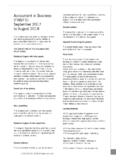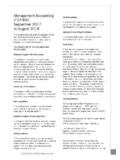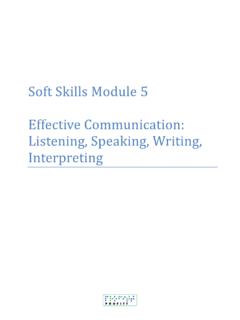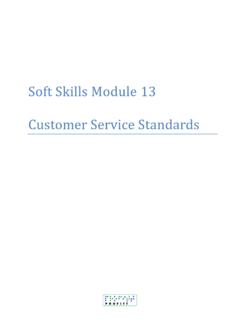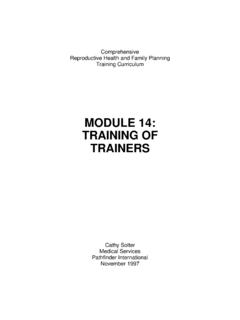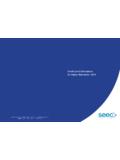Transcription of Ethics and Professional Skills Module
1 Ethics and Professional Skills Module Syllabus Ethics AND Professional Skills Module . SYLLABUS STRUCTURE. Syllabus structure UNIT 1: Ethics AND PROFESSIONALISM. This unit of the Module introduces the student to broad ethical and Professional values which underpin all the other Professional Skills and behaviours which are explored in this Module . Ethical and Professional values should provide a framework and a moral compass for the accountant to guide their behaviours in demonstrating the more specific Professional Skills as covered in this Module . Ethics AND PROFESSIONALISM Section 1: Ethics guide Section 4: Fundamental principles Summative exercise the learner a What is Ethics a About ACCA's fundamental is faced with a situation where they b Perspective on Ethics principles are expected to identify ethical c Branches of Ethics b ACCA's five fundamental principles dilemmas and take ethical decisions. d Ethics and gender test c Fundamental principles test e Ethics and morality f Ethics and religion Section 5: The framework g Ethics and maturity a The framework h Ethics and professions b The 4-step process i Summary c An ethical dilemma j Ethics guide test d Further considerations e Framework flowchart Section 2: Thinking about ethical f Code of Ethics quiz decisions a Thinking about ethical decisions Section 6: Case study b Accountant's dilemma test a Introduction c Moral reasoning theory b Overview of the case d Academic references c Meet the team d Iain's story Section 3: Rules v principles e Gail's story a Rules v principles b Some differences between rules and Section 7: The personal Ethics principles diagnostic and reflective exercise c Rules v principles test a Ethical perspective b The personal Ethics diagnostic and reflective exercise test Section 8.
2 Applying what you have learned a Applying what you have learned 2. Ethics AND Professional Skills Module . SYLLABUS STRUCTURE. UNIT 2: PERSONAL EFFECTIVENESS. The personal effectiveness unit is about maximising the quantity and quality of your work output and how you communicate and interact with others as you do so making the most of the resources that are available to you. The other key constraint that people face is the time that they have available to work within. The resources available to you are the mainly your own individual capacity to deliver your objectives at work and the amount and type of human and IT resources that you can use. The unit also helps PERSONAL EFFECTIVENESS. you maintain Professional competence and pursue life-long learning. Summative assessment the learner is faced with a challenging Section 1: Personal effectiveness Section 6: Big data analytics task or objective with insufficient a Introduction a Why is big data important?
3 Resources and a tight deadline b Data security and has to develop tactics and Section 2: Prioritising, organising and c Physical security strategies to ensure that the managing time effectively d Computer security task can be completed. a Introduction e Cyber security b Managing your time f What's my role? c Prioritising your time g Hidden object activity d The urgent/important principle h Security test e Ten ways to effectively manage i Personal effectiveness test your time Section 7: Maintaining Professional Section 3: Using technology competence and lifelong learning effectively a Continuing Professional a Using appropriate technology and IT development b Using email effectively b Personal development plan c How to manage email c How to craft your CV for the job of your dreams Section 4: Organising meetings d Your personal advertising campaign effectively e Key considerations in creating an a Organising virtual meetings and effective CV.
4 Managing diaries using appropriate f Other top tips software g Tips to prepare for an interview b Arranging a meeting h Getting it wrong c Organising meetings effectively test i Getting it right j Unit action plan Section 5: Using spreadsheets effectively Section 8: April's story a Effective use of spreadsheets a April's story b Virtual software 3. Ethics AND Professional Skills Module . SYLLABUS STRUCTURE. UNIT 3: INNOVATION AND SCEPTICISM. This unit of the Module is about encouraging open mindedness and innovative thinking. You will be able to suggest imaginative solutions to problems to create competitive advantage within the context of suitability, feasibility and acceptability, recognising the limitations of solutions and any problems with their implementation. The unit also introduces scepticism which is a personal quality required of accountants and those who need to think creatively and review the status quo to INNOVATION AND SCEPTICISM identify how things can be improved.
5 Summative assessment where the learner is presented with a Section 1: Innovation and Section 7: Promoting creativity in the situation where there are clues or scepticism workplace evidence of control weakness or a Innovation and scepticism a Introduction other business risks such as potential b Workplace innovation activity internet fraud or cyber' crime Section 2: Innovation c Momentum v inertia where the learner has to identify a Innovation d Group think what these are and offer innovative e How prepared are you to think solutions to rectify the weakness Section 3: Linear v lateral thinking creatively and innovatively or to help detect and prevent a Introduction f Some contemporary thoughts on the situation being repeated. b Rules of thumb creativity and proactivity at work c Systematic thinking d Lateral thinking Section 8: Professional scepticism e Summary and how to demonstrate it f Do you think laterally? a What do we mean by scepticism?
6 G Numbers exercise b Email exercise Section 4: The four P's of Section 9: The importance of innovation scepticism as an attitude a The four P's and the accountancy a Why is scepticism important profession activity b Scepticism continuum c Scepticism in practice Section 5: Great innovators d Investment decision a Great innovators e Last day of audit f Skills relevant to scepticism Section 6: Innovation and g Best practice competitive advantage a Competitive advantage Section 10: The innovation and b Benefits of being a fast second scepticism maze'. c Pre-requisites for being a fast second a The innovation and scepticism maze'. 4. Ethics AND Professional Skills Module . SYLLABUS STRUCTURE. UNIT 4: COMMERCIAL AWARENESS. This unit of the Module introduces the concept of commercial awareness as the ability to view situations from a commercial or business perspective, considering factors that influence the success of a business and an understanding the business processes, relationships, risks and costs.
7 Commercial awareness requires an ability to analyse the business environment, externally and internally, to evaluate available data and information from a variety of sources, some of which may not be relevant. You then will be able to identify opportunities, problems and observe trends and COMMERCIAL AWARENESS, make suitable recommendations based on these. ANALYSIS, EVALUATION. AND PROBLEM SOLVING. Section 1: Introduction Section 4: Professional self- Summative assessment where a Commercial awareness awareness the learner is presented with a Introduction a large and diverse amount Section 2: Commercial awareness and b SWOT analysis of data/information and must business acumen c Deciding when to seek the help of decide which data to use, a Introduction experts how to analyse and evaluate b Commercial awareness d Professional self-awareness it to make a recommendation c How to enhance your commercial e Unit action plan to senior management.
8 Awareness d PESTEL analysis Section 5: Data analysis and e Business acumen test manipulation a Introduction Section 3: Planning ahead and future b The importance of data analysis proofing c Your role in data analysis a Introduction d Ratio analysis test b Importance of planning ahead for e Data analysis and manipulation test business c Big business failures d Future proofing an organisation e Suitability, acceptability, feasibility (SAF) model 5. Ethics AND Professional Skills Module . SYLLABUS STRUCTURE. UNIT 5: LEADERSHIP AND TEAM WORKING. This unit of the Module introduces leadership and working in teams. The unit explores different type of leadership approaches and traits which can be adopted or adapted at any level of the organisation. This unit also demonstrates how effective leadership involves inspiring, motivating and supporting teams to work effectively and efficiently, making the most of the individuals within them.
9 LEADERSHIP AND Section 1: Introduction Section 7: Motivation TEAM-WORKING a Leadership and working in teams a Introduction Summative assessment where b The nature of motivation the learner is a leader who is Section 2: Leadership and c Motivation based on needs trying to manage a diverse group management d Motivational forces of individuals to achieve a task a Introduction e Motivators and dissatisfiers within a team and the learner must b The nature of leadership f The expectancy approach to identify the type of manager they c Situational leadership motivation are and the style they are adopting d Leadership in action g Summary and the potential issues with their approach to achieving the task. Section 3: Leadership styles Section 8: Accountability, The tasks will involve tracking the a Leadership styles responsibility and authority progress of the leader in making b Blake and Mouton grid a What can go wrong? and communicating decisions to the c What type of leader are you b Accountability, responsibility and team and advising on whether the authority decisions and behaviour adopted Section 4: Putting effective c What do these concepts mean?
10 Were appropriate at each stage. leadership into practice d Delegation of authority a Introduction Section 9: End of unit assessment Section 5: Examples of outstanding a Introduction leaders b Question 1. a Outstanding leaders c Three years later d Question 2. Section 6: Teams e Final accounts preparation a Introduction f Question 3. b Team roles g Question 4. c Team development 6. Ethics AND Professional Skills Module . SYLLABUS STRUCTURE. UNIT 6: COMMUNICATION AND INTERPERSONAL Skills . This unit is specifically about how we communicate effectively with others in a business environment, including clients, customers, colleagues and external authorities. This unit covers patterns and channels of communication and how effective these are in different contexts and the associated methods and Skills involved in advising, supporting, motivating and influencing others. Section 1: Introduction Section 8: Telephone COMMUNICATION AND.
